
LIGHT BENT BACKWARD, WAITING TO BE FORGOTTEN _____ 29.05.2025 – 15.06.2025
arka arka, Vienna, AT
The exhibition Light bent backward, waiting to be forgotten brings together three artistic practices in which light, traditionally a symbol of visibility, knowledge, and truth no longer moves forward. It refuses to be guiding, all-penetrating. Instead, it turns toward oblivion, distortion, and transformation. Light no longer illuminates but recedes, like memory, like voice, like a trace dissolving into matter. The deviation backward becomes a gesture pointing to resistance against the linearity of time, or to something that once moved forward but now unexpectedly retreats. This is exhibition about what becomes invisible, elusive, unfixable, about materials susceptible to decay. About structures that seem clear at first glance but conceal duality, violence and ideology.
In the practice of Nabil Aniss, light is less a visual phenomenon and more an inner energy that arises through sound, movement, trance, and self-harm. Aniss engages with the history of oppression and mysticism as acts of liberation. In his new work Structures and Positions, Aniss refers to Michel Foucault’s essay The Utopian Body, in which the body is described as elusive, both real and impossible. In this film, the body becomes an "in-between" space, oscillating between visibility and disappearance, between social control and emancipation. Light here serves as a metaphor for a utopian gesture: a departure from fixed bodily identities and the unveiling of spaces of freedom hidden within ritual. In his films, bodies become sources of light that, however, deviate backwards. Inward, toward their origins.
Céline Struger works within a space where the organic and the artificial, the material and the fluid, interact in an eternal cycle of transformations. Her sculptures and installations are traces of processes that have already begun and are yet to be completed. Water, her primary material, flows through forms, changes them, and destroys them. It interacts with rust, tannins, and pigments, creating painterly traces of time, erosion, and entropy. In her practice, light is not an illuminating spotlight but a reflection, fleeting and temporary. Light may vanish into rust, dissolve in water, or be absorbed by porous surfaces. Here, light is decay. It deviates backwards, becoming a material trace of a lost presence. The space Struger creates is one where the sacred collides with the abandoned.
In her practice, Sofiia Yesakova uses visual strategies that deliberately conceal emotional content within strict minimalist forms, prompting viewers to search for and carefully consider hidden meanings. Her works point to how a “pure” visual language can mask the violence of systems and ideologies. Yet within these schematics, there is a disruption. The lines are too thin, the images too fragile, the materials too alive, as if living imagery interrupts and destabilizes the rigid structures. Here, light is no longer absolute; it cracks, trembles, and loses focus. It deviates backwards, toward the pre-rational, the sacred, the iconological memory torn from its context and placed into a new space.In the works presented, the motif of bone decay (osteosarcoma) symbolizes the confrontation of physical form with human vulnerability.
Across all three artistic positions, light is something that no longer strives toward the center. It slips away. It no longer points the way but turns toward the past, toward the body, toward ritual, toward material. It deviates backwards, to where memory is inseparable from forgetting, where form disintegrates in order to be reborn.
Curated by Anzhelika Palyvoda
Text by Sofiia Yesakova
Group exhibition alongside artists Céline Struger and Nabil Aniss
Part of Independent Space INDEX Vienna
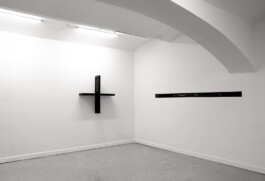
Ugly scenes. Nuances 4.1., 100 × 100 × 5 cm (x2), black wood, linseed oil, beeswax, funeral ribbon, 2025
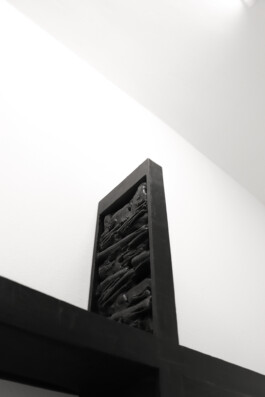
In the series of works Ugly Scenes. Nuances, I engage with the philosophical inquiries of Gilles Deleuze, exploring the concepts of layering, differentiation, repetition, vibration, and the multilayered nature of reality, where processuality and oscillations are the fundamental principles of existence. Contrasts, as an inseparable part of the historical process, structure perception, and my work is aimed at contemplating these oppositions within the context of rigid philosophical and social constructs. Within this framework, I adhere to the theory of "punitive restraint" (Foucault), where concealing the emotional component, seemingly cut by anxiety, becomes an act of control over perception and an attempt to focus on intellectual analysis.
My visual narrative draws inspiration from religious symbolism, often used in sacred art, and the strict conventions of minimalism. The fragile vertical lines of the works contrast with contextual elements, creating tension between form and content. Modernity, immersed in anxiety and catastrophization, demands organization, even in the most chaotic reality.
Particular attention in the works is given to elements of bone deterioration, a symbol of the confrontation between physical form and human vulnerability, both physically and mentally. Bone erosion serves as a metaphor for inevitable mortality and reflects the eternal clash between decay and renewal. Here, a dichotomy arises: decay gives meaning to life and simultaneously provokes anxiety. Bone is the foundation of the human body, its core, but disorganized bone deterioration destroys this stability, reminding us of the fragility of existence. However, destruction is not an end, but a movement—the decay of the old opens space for the new.
Additionally, I use elements visually similar to the works of artist Hans Schwarz, particularly his piece "Death and the Maiden", to create a dialogue that highlights issues that still concern us all, with a 500-year gap. This allows the modern viewer to reconsider timeless themes, despite cultural and historical differences.
Aesthetic visualization of violent scenes in different eras traditionally carried a cathartic function, conditioned by eschatological consciousness and collective fears. When encountering images of violence, we face a whole spectrum of emotions that have a "cleansing" effect. This phenomenon can be observed in the Renaissance and Baroque periods, where the tragedy of the individual served as a metaphor for the tragedy of the world. In my works, this interconnection is also evident, linking personal and global tragedy through the language of art.
Text by Sofiia Yesakova on the series of works Ugly Scenes. Nuances
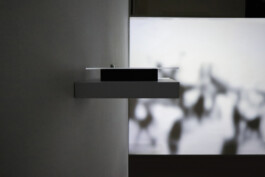
Ugly scenes. Nuances 2.1., 15 × 5 × 3 cm (x2), black wood, linseed oil, acrylic glass, 2025
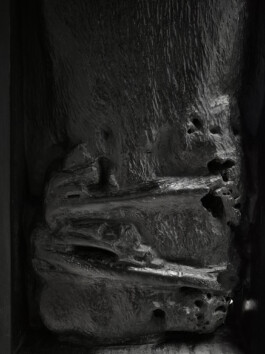
Ugly scenes. Nuances 4.1., 100 × 100 × 5 cm (x2), black wood, linseed oil, beeswax, funeral ribbon, 2025. Close-up
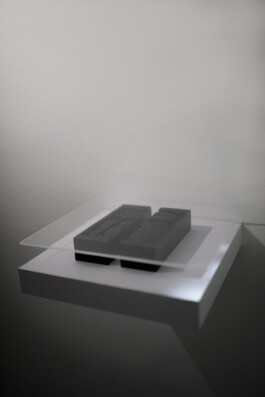
Ugly scenes. Nuances 2.1., 15 × 5 × 3 cm (x2), black wood, linseed oil, beeswax, acrylic glass, 2025. Close-up
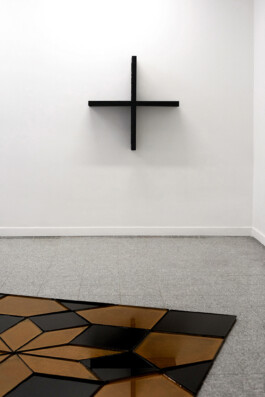
Installation view alongside Céline Struger’s work
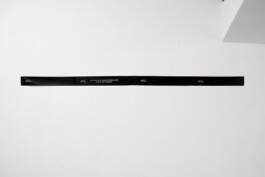
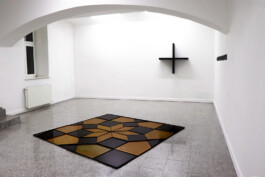
Installation view alongside Céline Struger’s work The Foreboding
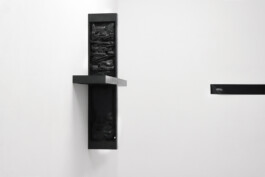
Ugly scenes. Nuances 4.1., 100 × 100 × 5 cm (x2), black wood, linseed oil, beeswax, funeral ribbon, 2025. Close-up

Ugly scenes. Nuances 2.1., 15 × 5 × 3 cm (x2), black wood, linseed oil, beeswax, acrylic glass, 2025
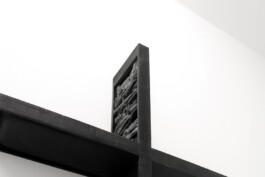
Ugly scenes. Nuances 4.1., 100 × 100 × 5 cm (x2), black wood, linseed oil, beeswax, 2025. Close-up
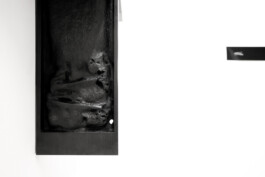
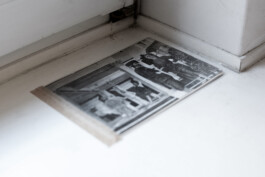
postcard depicting painting of Piero della Francesca